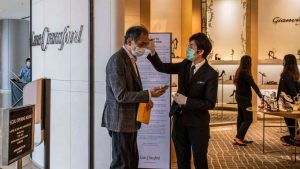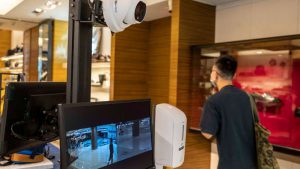MAY 12, 2020

At Lane Crawford in Hong Kong, customers have their temperature checked as they arrive at the store. – Lam Yik Fei / NY Times
When department stores reopen their doors, a familiar whoosh will still greet customers at the entrance: the sudden gust of air-conditioning, the gleam of polished marble floors, the sensation of not really knowing where to start.
But beyond the doors, new and unfamiliar sights await: hand-sanitizer dispensers scattered on every surface, employees smizing through their face masks, signs displaying checklists of “what we’re doing to keep you safe.” When Saks Fifth Avenue reopened in Houston, the store stamped a trail of warnings on its white tile floors, in blocky black text, asking shoppers to “please maintain social distancing of at least six feet from others.”
This is department-store shopping during a pandemic.
After months of lockdown, the world of retail is reawakening. Stay-at-home orders are beginning to lift, even as coronavirus-related deaths mount. And in those places, department stores — when not preparing to file for bankruptcy — have been among the first to come back, rolling out detailed safety plans.
Saks Fifth Avenue began unlocking its doors in Texas last Friday and said it aims to open a few Ohio and Florida stores this week. Galeries Lafayette began to reopen its stores in France on Monday. Nordstrom said that by early this week, the company plans to have 32 stores open — a combination of full-line stores and Nordstrom Rack locations in South Carolina, Texas, Oklahoma and Tennessee. Selfridges and Harrods are also expected to reopen in the coming weeks, subject to British government directives.

Here, a temperature scanner at Lane Crawford. – Lam Yik Fei / NY Times
So far their plans are similar: Employees will wear face masks and submit to health screenings; some store layouts will be reconfigured to create more space and promote one-way traffic flows; customer capacity will be limited; stores will be cleaned more often; hours will be reduced; hand sanitizer will be liberally available; in-store events or any services requiring close contact (beauty tutorials, bra fittings) will be suspended or adapted.
There are also a few differences: At Nordstrom all employees will wear gloves, for example; at Saks they will not.
Yet even with these plans announced, or soon-to-be announced, none of the retailers know how they’ll be received.
“We have this idea of what it’s going to look like when we open the doors,” said Jamie Nordstrom, the company’s president of stores. “We’ll be wrong about half of it.”
Despite years of financial turmoil, the purpose of department stores has largely remained unchanged. They are still one-stop shops for a sprawling catalog of goods; they are still home to Santa Claus photo ops and panic buying before the holidays; they still exist in the imagination as settings for movie makeovers and dressing-room montages.
Many people are hungry to have this kind of shopping experience again. But many are also feeling “psychologically vulnerable,” said Michael R. Solomon, a consumer behavior consultant.
“Obviously it’s going to be a downer,” he said. “Nobody wants to be out there wearing a mask, even if it’s from Gucci.”
Consumers may turn to shopping, as they have in the past, to deal with the emotional stress of this moment. Yet how can they escape that stress when they’re surrounded by reminders of it?
“The most basic thing people will be looking for is health and well-being: Am I going to be safe?” said Mary Portas, a retail consultant and broadcaster. “That said, the fact people want to come to that space means they are going to buy. They have made the effort. They have intention.”
First Impressions
Like upscale hotels and restaurants, high-end department stores have always tried to hide their maintenance efforts from customers, lest a stray floor buffer dim the luster of luxury. Not anymore.
For pandemic-era retailers, the more obvious signs of cleaning, the better. One commercial cleaning company, Enviro-Master, has even begun offering clients certificates to hang in their windows proving they received a “virus vaporizer” service.
Visibility offers reassurance, and wary shoppers need reassurance. That starts at the entrance to their stores.
“It’s important that the measures implemented are visible and become rituals,” said Andrew Keith, the president of Lane Crawford, the high-end department store chain in Hong Kong and China (where its locations, bar one in a Beijing mall, remained open throughout the coronavirus outbreak).
Mr. Keith said that his store’s employees, like most others, must wear masks and have their temperatures checked when they arrive. So must Lane Crawford customers (who also declare their travel histories). Such policies are unlikely to catch on in other regions, Ms. Portas said.
“I can’t see somewhere like Britain having temperature checks on every entry and exit point for customers,” she said. “It doesn’t feel like a cultural fit. What feels reassuring in Asia might feel off-putting here, when buying a new piece of fashion. It is still about selling a dream, after all, even if this is the new retail reality.”
This is the challenge of reopening an upscale department store right now: fitting the dream of luxury shopping — “the treasure hunt,” as Mr. Solomon put it — into the anxious reality of an ongoing pandemic.
“In stores like this, you want to appeal to the senses, and not just visually,” he said. “You want to use textures and touch — and wearing gloves and so on doesn’t help that. So you design around that.”
MJ Munsell, a retail designer and the chief creative officer at MG2, an architecture firm in Seattle, offered a number of ways retailers can manufacture warm environments upon entry. They could have associates show personality with customized protective gear; build elaborate and delightful displays of merchandise; diffuse memory-evoking fragrances throughout the store; or play high-quality music to boost energy, particularly when there are fewer shoppers around.
Companies shouldn’t take these steps only at their outsize flagships in New York or Los Angeles, Ms. Munsell added, but at their comparatively overlooked suburban locations, too.
“The retailer who is going to succeed is going to understand the value of that suburban experience,” Ms. Munsell said.
Nordstrom said its strategy for its 116 locations (soon to be 100, with many in suburbia) is to “overcommunicate.” Before reopening, the company wants to prepare shoppers for what to expect by posting photos and videos of the changes on social media. It wants to hold customers’ hands — in a gloved, socially distant kind of way — from the moment they walk in (and are handed a disposable mask) to the moment they check out (behind a plexiglass partition).
“We’re thinking about how we really double down on communicating, not just through signs or tape on the ground,” Mr. Nordstrom said, “but literally communicating — having people at the doors talking customers through what’s going on, guiding them throughout their journey in whatever way customers want.”
Who Gets to Be a V.I.P.?
The beating heart of a department store is the beauty counter — typically on the first floor, near a busy entrance, staffed with eager and eagle-eyed representatives from each brand.
Makeovers and smoky-eye tutorials happen here. Perfumes are spritzed and moisturizers are sampled there. A lot of money is spent. But without skin-to-skin contact, the experience of testing and purchasing products will change dramatically.
“Brands are going to have to be very inventive,” Ms. Munsell said. “We still need someone to help us through the vast assortment of choices.”
Virtual try-ons — technology already used by Sephora and Ulta, among others — could become standard. Employees will need to find new ways of demonstrating how to use products; they may still be able to put eye makeup on a customer (though that could violate social distancing), but lipstick and bronzer can’t be applied behind a face mask. And not everyone will want a high-touch, high-technology experience.
As with makeup, the experience of trying on clothes in a fitting room — those small, and confined, shared spaces — will also change.
“Are customers going to feel safe going into a dressing room?” Ms. Munsell said. “Do we need to consider spacing them out or making them larger? Having them be by-appointment so they can be sanitized by a sales associate in advance?”
At Saks and Nordstrom, clothing brought into fitting rooms will be quarantined for a period of time (48 hours at Saks, 72 at Nordstrom) before being returned to the sales floor. The same goes for returns — and Nordstrom expects its first few days back in business to be dominated by returns of merchandise bought online during lockdown.
At Saks, foot coverings used when trying on shoes will also be thrown out after one use. Nordstrom will rely on visibility, spacing out dressing rooms and posting forms indicating the last time they were cleaned — which will be after every customer, the company said.
If this all sounds like a more intimate, personalized and V.I.P.-style experience than the traditional shopping trip, that’s intentional.
Most high-end department stores are expecting foot traffic declines in the high-double digits when they reopen their doors, particularly in cities dependent on tourist shoppers. In Paris, Nicolas Houzé, the Galeries Lafayette chief executive, said that he does not expect to see a return to normal levels of business until the end of 2021, adding that it had lost “hundreds of millions” of euros worth of expected sales.
But the expectation is that those shoppers who do return in the coming months will be far more likely to buy. Simply put, retailers need to be selling more goods to fewer shoppers. And that means rolling out the red carpet.
“Last Monday, we had an extraordinary transaction in Beijing,” said Mr. Keith of Lane Crawford. “A customer contacted her stylist and said she was making one of her first journeys outside her home since January, and she wanted to come to the store but only had an hour. She bought 80 pieces of ready-to-wear and accessories, a total transaction of 1.4 million renminbi” — around $200,000 at current conversion rates — “in that hour.”
A tiny handful of shoppers can afford such a spending spree, but customers should expect a higher degree of service and attention, regardless of how much they can spend.
Marc Metrick, the president of Saks, said that while store hours will be reduced, the company will offer by-appointment shopping before opening and after closing, “giving people the opportunity for one-on-one service when the store is limited to just a few customers.” Virtual appointments to shop via video conferencing are also in the pipeline. Lane Crawford has introduced an app that lets associates send personalized looks to customers.
Associates will play a more important role than ever before in making shoppers feel comfortable in what may initially feel like clinical or alien surroundings.
“Retailers often talk about how it starts with a smile,” Mr. Nordstrom said. “That gets harder when you’re wearing a mask.”
Dine and Dash
Before the pandemic, retailers were increasingly entering the hospitality business. But for now, department-store dining options — from coffee shops to cocktail bars — in cities like London and New York are shuttered. When they do reopen, most will adhere to the local directives are in place for the hospitality industry, from double spacing between tables and online rather than physical menus.
“It’s certainly going to look different for some period of time,” Mr. Nordstrom said.
In Britain at least, food service has started to resume in some department stores. The food hall at Selfridges reopened on May 1, albeit with a limited number of shoppers allowed inside, a one-way traffic policy, hand sanitizer pumps everywhere and sneeze guards for staff, who also have their temperatures checked once a day.
Eventually, it’s assumed, food and beverage service will return to normal. Strict social distancing measures will be relaxed — like Saks’s decision to close off elevators to customers unless they are elderly, pregnant or disabled. (Escalators are still in service, though steps will be marked to keep shoppers six feet apart.)
But the last stop customers usually make at a department store — the cash register — may permanently change.
At Lane Crawford, centralized cash registers have been replaced by remote points of sale to limit lines, while associates roam floors with tablets or phones (wearing gloves to handle all cash and credit card transactions).
Western department stores are likely to follow suit, with many looking at how to install contactless checkout and create more space at stores for curbside pickup and returns and “click and collect” stations, where customers can claim items they already bought online.
According to Ms. Portas, these services will become increasingly important as customers adjust to shopping in the Covid-19 era. Many shoppers will be too nervous or unable to browse or linger in line, she said. Ms. Munsell added that she expected to see more stores using Apple Pay, or their own apps, for payment transactions.
Department stores were already becoming more technologically savvy, bridging their e-commerce and brick-and-mortar businesses. Covid-19 has meant that these efforts have been accelerated by a few years. But this acceleration will require money and time, which were in short supply even before the lockdown began devastating retailers.
Still, Mr. Nordstrom appeared sanguine in the days leading up to his stores’ reopening announcement, as if accustomed to his industry’s constant and ruthless change.
“A lot of old department stores that have gone away over the last 20 to 30 years — they stopped changing, they stopped evolving,” he said. “The minute you stop evolving, the customer is going to move on. Who knows what curveball gets thrown at us a week from now?”
Courtesy/Source: NY Times











































































































